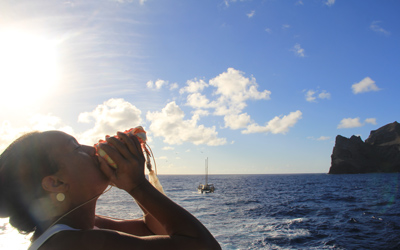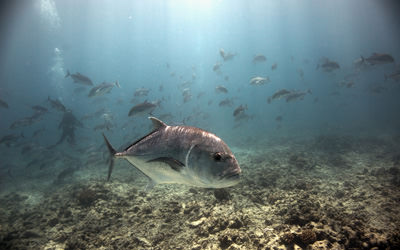Papahānaumokuākea Celebrates 15 years as a monument

On June 15, 2006, the Northwestern Hawaiian Islands Marine National Monument was designated by President George Bush, creating the largest marine conservation area on Earth at the time. A year later, it was given its Hawaiian name, Papahānaumokuākea. Papahānaumoku is a mother figure personified by the earth and Wākea is a father figure personified in the expansive sky; the two are honored and highly recognized ancestors of Native Hawaiian people.

This year we celebrate 15 years of accomplishments in cooperative conservation and co-management. In August of 2021, we also celebrate the fifth anniversary of the expansion of Papahānaumokuākea by President Barack Obama. Encompassing 582,578 square miles of the Pacific Ocean (1,508,870 square kilometers), it remains one of the largest marine conservation areas in the world.
Various protection efforts in the region have been enacted for more than a century, beginning in 1903 when President Theodore Roosevelt sent in the U.S. Marines to stop the slaughter of seabirds for feathers and eggs at Midway Atoll. Over the next 118 years, six U.S. Presidents and one Hawaiʻi Governor afforded the region increasing protection. The region is also globally recognized as a UNESCO Mixed World Heritage Site, inscribed for both its natural and cultural values to mankind, and as a Particularly Sensitive Sea Area under the International Maritime Organization.

Papahānaumokuākea is a birthplace of rich ocean diversity where a living story of creation, exploration, and valor is remembered and shared throughout Hawai‘i and the world. People value the monument as a place of regeneration and renewal -- a place of hope where an abundance of species thrive to nourish our minds and bodies and stir our ancient need for a natural state where man is just one part of a whole.
Papahānaumokuākea awakens a truth that most have forgotten—that we need a healthy ocean for our well-being. It reminds everyone that nature and culture are one; and the traditional and conventional, spiritual and scientific have learned to coexist.
In celebrating our 15th anniversary, we need to remember that it is due to the vision of many, and to the increasing layers of protection that have been afforded this place over time, that we are able to malāma (care for) and treasure this sacred place. We very much honor the legacies of those kūpuna (elders) and others who have provided their mana‘o (thoughts and ideas) and given freely of that ʻike (knowledge) and wisdom to protect a special place that many call a pu‘uhonua (refuge), and ‘āina momona (place of abundance). We must continually strive to ensure a healthy, thriving paeʻāina (archipelago) for future generations. We must also acknowledge the work of those who have spent months at a time living in isolation at remote field camps throughout these islands and atolls. They have worked to restore, conserve, and protect a multitude of endangered and threatened species found nowhere else on Earth, who call this place home.
This celebration and significant milestone should honor all, whether in the field doing research, in the boardroom, in the classroom, at outreach events, or providing hundreds of hours of volunteer services to conserve this special place.

Papahānaumokuākea represents a new way of managing where federal, state, and Indigenous community voices have equal say in how a place is managed. It is a place where nature and culture are one, and where we strive to incorporate western science and Indigenous knowledge in all aspects of management. Each day brings new challenges and new opportunities to learn from each other, to grow as a community, and to strive to do our best to continue to care for this special place. To all of you who have been a part of this journey – mahalo!
This June, Papahānaumokuākea celebrates 15 years as a marine national monument. It is jointly administered by four co-trustees: NOAA, U.S. Fishand Wildlife Service, the state of Hawaiʻi, and the Office of Hawaiian Affairs. Management of the monument is overseen by NOAA’s Office of National Marine Sanctuaries, NOAA Fisheries, U.S. Fish and Wildlife Service Ecological Services and Refuges Program, state of Hawai’i Divisions of Aquatic Resources and Forestry and Wildlife, and the Office of Hawaiian Affairs.
View Governor David Ige’s Proclamation in Support of the 15th Anniversary of Papahānaumokuākea Marine National Monument and UNESCO World Heritage Site.


